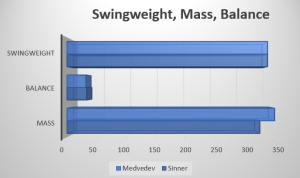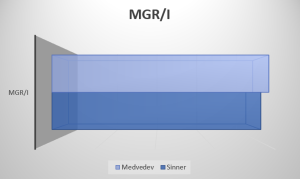In this year’s edition of the 2024 Australian Open final, we witness a captivating intersection of physics, mechanics, and raw athletic talent. Daniil Medvedev, with his established pedigree in Grand Slam finals, faces the emerging force, Jannik Sinner. This confrontation is not just a display of skill and will but also a fascinating study in the engineering of tennis rackets and their profound impact on gameplay.

Jannik Sinner: The Dynamics of the Speed MP TGT301.4
Sinner, the young Italian maestro, wields a Speed MP TGT301.4, a racket that embodies dynamism of play and of engineering that complements his aggressive style. Weighing in at only 327g, with a balance point of 33.3 cm and a swingweight of 340, resulting in lover MGR/I, this racket is a study in the optimization of mass distribution for rapid swing dynamics. The polarized setup – lighter overall mass with a relatively higher swingweight – facilitates a whip-like action, ideal for generating high topspin rates. This is crucial for Sinner’s game, allowing him to create acute angles and exert dictatorial control over rallies. He also strings his racket with 1.30 thickness strings at around 28 kg, which gives him the needed control with high swing speed, but also requires him to always swing fast to create the necessary strings’ movement.
From a mechanical standpoint, Sinner’s racket setup demands precise timing and exceptional hand-eye coordination. The challenge in a high-stress scenario like a Grand Slam final is maintaining this precision over potentially 5 long, grueling sets. His tactical approach, involving aggressive baseline play and timely net approaches, hinges on this precision. The match’s outcome may well pivot on Sinner’s ability to sustain this level of mechanical efficiency.
Daniil Medvedev: Techifibre DC 305 – A Model of Consistent Force Transfer
On the other side, Medvedev’s choice of the Techifibre DC 305 is a testament to his preference for consistency and energy efficiency. Weighing approximately 353-355g with a balance point of around 32 cm and a relatively low swingweight, this racket is a perfect fit for Medvedev’s methodical, baseline-dominant game. The racket’s mass, swingweight and balance resulting in higher MGR/I, coupled with its string pattern and smaller 95 sw. inch head size, offer a blend of power, fogiveness and control that complements Medvedev’s flat, deep groundstrokes. He also strings pretty loosely at around 21 kg, making his racket even more energy efficient, while creating the pall pocketing and trampolin effect.
Medvedev’s racket setup maximizes energy transfer with minimal loss, crucial for his flat shot-making style. It allows him to generate pace without excessive physical exertion – a key factor in long matches. The slightly head-light balance aids in quick adjustments, essential for countering Sinner’s high-energy shots.

The Final Analysis: A Collision of Styles and Engineering
This final is a fascinating study in contrasts, not just in playing styles but in the underlying physics of their equipment. Sinner’s racket is engineered for speed and spin, demanding physical agility and precision. Medvedev’s, in contrast, is a model of efficiency and consistency, designed to maximize energy transfer and minimize physical strain.
The match will likely be a test of Sinner’s ability to maintain his high-energy, high-precision game against Medvedev’s relentless consistency. For Medvedev, the challenge will be to disrupt Sinner’s rhythm and exploit any lapses in precision.
Conclusion: Beyond the Physical to the Mental
Beyond the mechanical aspects, there’s the mental game. Medvedev, with his experience in finals, while also winning 1 grand slam, carries the weight of expectation and past disappointments. Sinner, in his first Grand Slam final, bears the pressure of potential and the prospect of a breakthrough and proving he is the future of men’s tennis, as many of us think.
In essence, this final is a showcase of the symbiotic relationship between player and racket, each enhancing the other’s strengths. As we witness this clash of titans, observe not just the players but the tools in their hands – extensions of their physical and strategic selves, engineered for victory.
I try to make the finals more interesting as you can observe the different rackets and strategies behind them at work. If you are interested in more racket specs that tour players use, check my database.